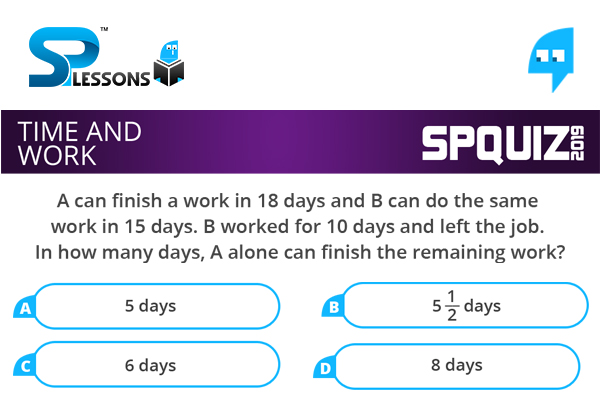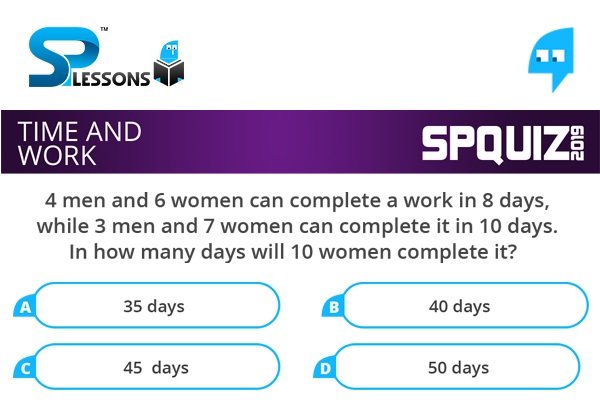 Introduction
Introduction
Time and Work is one of important topic in Quantitative Aptitude Section. In Time and Work – Quiz 2 article candidates can find a question with an answer. By solving this question candidates can improve and maintain, speed, and accuracy in the exams. Time and Work - Quiz 2 questions are very useful for different exams such as IBPS PO, Clerk, SSC CGL, SBI PO, NIACL Assistant, NICL AO, IBPS SO, RRB, Railways, UPSC, IES and Civil Services etc.
 Q1
Q1
A can do a piece of work in 4 hours; B and C together can do it in 3 hours, while A and C together can do it in 2 hours. How long will B alone take to do it?
- A. 8 hours
B. 10 hours
C. 12 hours
D. 24 hours
A's 1 hour's work = [latex]\frac{1}{4}[/latex];
(B + C)'s 1 hour's work = [latex]\frac{1}{3}[/latex];
(A + C)'s 1 hour's work = [latex]\frac{1}{2}[/latex];
(A + B + C)'s 1 hour's work = [latex](\frac{1}{4} + \frac{1}{3}) = \frac{7}{12}[/latex].
B's 1 hour's work = [latex](\frac{7}{12} - \frac{1}{2}) = \frac{1}{12}[/latex].
i.e, B alone will take 12 hours to do the work.
 Q2
Q2
A can do a certain work in the same time in which B and C together can do it. If A and B together could do it in 10 days and C alone in 50 days, then B alone could do it in:
- A. 15 days
B. 25 days
C. 20 days
D. 30 days
(A + B)'s 1 day's work = [latex]\frac{1}{10}[/latex]
C's 1 day's work = [latex]\frac{1}{50}[/latex]
(A + B + C)'s 1 day's work = [latex](\frac{1}{10} + \frac{1}{50}) = \frac{6}{50} = \frac{3}{25}[/latex]............(i)
A's 1 day's work = (B + C)'s 1 day's work .... (ii)
From (i) and (ii), we get: 2 x (A's 1 day's work) = [latex]\frac{3}{25}[/latex]
[latex]\Rightarrow[/latex] A's 1 day's work = [latex]\frac{3}{50}[/latex]
i.e, B's 1 day's work [latex](\frac{1}{10} - \frac{3}{50}) = \frac{2}{50} = \frac{1}{25}[/latex]
So, B alone could do the work in 25 days.
 Q3
Q3
A does 80% of a work in 20 days. He then calls in B and they together finish the remaining work in 3 days. How long B alone would take to do the whole work?
- A. 23 days
B. 37 days
C. 37 [latex]\frac{1}{2}[/latex] days
D. 40 days
Whole work is done by A in
[latex](20 \times \frac{5}{4})[/latex] = 25 days.
Now, [latex](1 - \frac{4}{5})[/latex] i.e, [latex]\frac{1}{5}[/latex] work is done by A and B in 3 days.
Whole work will be done by A and B in (3 x 5) = 15 days.
i.e, B's 1 day's work = [latex](\frac{1}{15} - \frac{1}{25}) = \frac{4}{150} = \frac{2}{75}[/latex]
So, B alone would do the work in [latex]\frac{75}{2} = 37 \frac{1}{2}[/latex] days
 Q4
Q4
A can finish a work in 18 days and B can do the same work in 15 days. B worked for 10 days and left the job. In how many days, A alone can finish the remaining work?
- A. 5 days
B. 5 [latex]\frac{1}{2}[/latex] days
C. 6 days
D. 8 days
B's 10 day's work = [latex](\frac{1}{15}\times 10) = \frac{2}{3}[/latex]
Remaining work = [latex](1 - \frac{2}{3}) = \frac{1}{3}[/latex]
Now, [latex]\frac{1}{18}[/latex] work is done by A in 1 day.
i.e, [latex] \frac{1}{3}[/latex] work is done by A in [latex](\frac{1}{3}\times 18)[/latex] = 6 days
 Q5
Q5
4 men and 6 women can complete a work in 8 days, while 3 men and 7 women can complete it in 10 days. In how many days will 10 women complete it?
- A. 35 days
B. 40 days
C. 45 days
D. 50 days
Let 1 man's 1 day's work = x and 1 woman's 1 day's work = y.
Then, 4x + 6y = [latex] \frac{1}{8}[/latex], and 3x + 7y = [latex] \frac{1}{10}[/latex]
Solving the two equations, we get: x = [latex] \frac{11}{400}[/latex], y = [latex] \frac{1}{400}[/latex]
i.e, 1 woman's 1 day's work = [latex] \frac{1}{400}[/latex]
[latex]\Rightarrow[/latex] 10 women's 1 day's work = [latex](\frac{1}{400} \times 10) = \frac{1}{40}[/latex]
Hence, 10 women will complete the work in 40 days.








